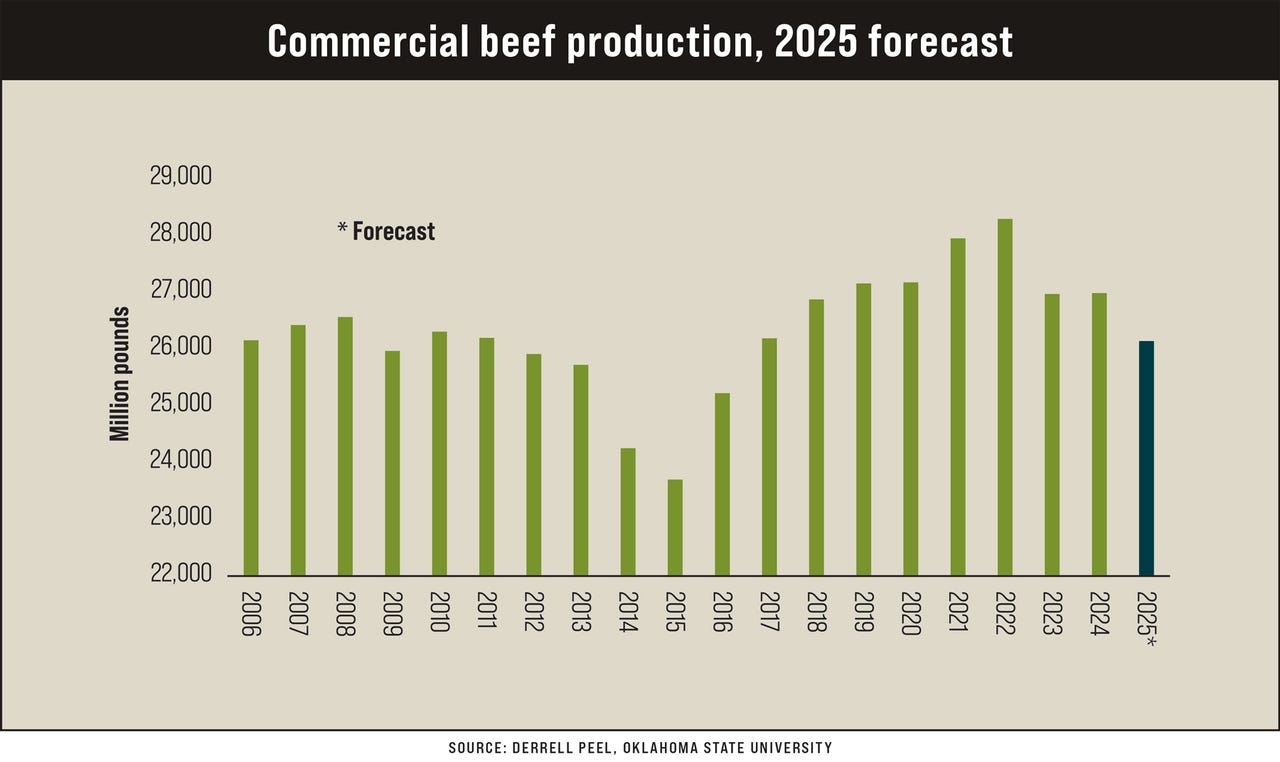The media in America has been full of stories about high beef prices this summer, and consumers are only now aware of the beef industry situation that has been developing for several years.
Beef prices are being pushed higher by tight cattle supplies and stronger cattle prices.
The reported July all-fresh retail beef price was $8.90 per pound, a record. In late August, Choice boxed beef prices reached about $412 per cwt, a record level except for two weeks of supply-chain disruption during the pandemic.
Wholesale and retail beef prices are supported by continued strong consumer demand and declining beef production, projected to be down 3% or more year over year.

There is no quick fix, and beef production is projected to decline further in 2026 and possibly beyond. Consumers will face high and even higher beef prices for another two to three years at least.
Beef supplies tighten
Feedlot inventories were down in August for the eighth consecutive month. In fact, the August feedlot inventory of 10.92 million head was the smallest monthly inventory since October 2017.
Placements in feedlots are down more than 6% year over year the past six months, suggesting that feedlot inventories will continue to decline. Feedlot marketings were down more than 5% year over year in the past six months, leading to decreased fed cattle slaughter and lower beef production.
Beef production is down 2.7% for the first seven months of the year compared with a year ago.
Starting in the second quarter, beef production dropped more sharply, and it has been down 5.2% year over year in the past 20 weeks. Fed beef production is down 1.5% this year compared with last year and combines with continuing decreases in nonfed beef production, down 9.5% year over year, to pull total beef production down after it held steady last year.
Beef sectors face tough decisions
Cattle producers responded to unimaginable prices by selling cattle, frequently unweaned, early this summer.
Feeder cattle prices increased over 30% from the beginning of the year through August, with fed cattle prices up over 21% this year. This type of selling cuts into the normal fall run and will keep feeder cattle supplies seasonally tight through the end of the year.
With the value of calves ranging from $2,000 to $3,000 per head, cow-calf producers continue to wrestle with the temptation to sell all calves or choose to forgo heifer sales and retain some for breeding.
Additionally, with cull cow values ranging from $2,000 to $2,500 per head, producers have individual incentives to cull diligently. However, the industry is reducing overall culling rates, possibly in anticipation of herd rebuilding efforts.
The long road ahead
It appears that cattle inventories may stabilize this year, and the beef cow herd could be steady or perhaps fractionally higher going into 2026. However, prospects for herd growth in the coming year are limited by the small supply of replacement heifers in the pipeline. Moreover, with no indication of significant heifer retention yet, prospects for herd growth in 2027 are dwindling rapidly.
If heifer retention begins in the final months of 2025, those heifers can be bred in 2026 to calve in 2027, resulting in increased beef production in 2028 at the earliest. The timeline gets pushed out another year if heifer retention does not begin soon.
In the meantime, tight supplies get tighter when retained heifers are pulled out of feeder supplies. Cattle prices would not be expected to peak until several months to a year and a half after heifer retention begins.
The apparent slow grind to herd rebuilding suggests sustained high cattle prices until late in the decade, with a gentle peak somewhere along the way. Consumers will face elevated costs for at least two to three more years.
Source: Derrell Peel (Farm Progress)

 Facebook
Facebook  Youtube
Youtube  VN
VN

 Youtube
Youtube  Linkedin
Linkedin  Facebook
Facebook 
